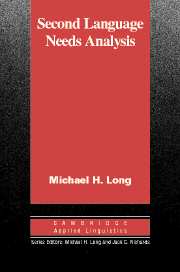Book contents
- Frontmatter
- Contents
- List of contributors
- Acknowledgments
- Overview: A rationale for needs analysis and needs analysis research
- I Methodological issues
- II The public sector
- III The occupational sector
- IV The academic sector
- V Analyzing target discourse
- Chapter 9 Collecting target discourse: The case of the US naturalization interview
- Chapter 10 A double shot 2% mocha latte, please, with whip: Service encounters in two coffee shops and at a coffee cart
- Chapter 11 When small talk is a big deal: Sociolinguistic challenges in the workplace
- Index
Chapter 9 - Collecting target discourse: The case of the US naturalization interview
Published online by Cambridge University Press: 25 January 2010
- Frontmatter
- Contents
- List of contributors
- Acknowledgments
- Overview: A rationale for needs analysis and needs analysis research
- I Methodological issues
- II The public sector
- III The occupational sector
- IV The academic sector
- V Analyzing target discourse
- Chapter 9 Collecting target discourse: The case of the US naturalization interview
- Chapter 10 A double shot 2% mocha latte, please, with whip: Service encounters in two coffee shops and at a coffee cart
- Chapter 11 When small talk is a big deal: Sociolinguistic challenges in the workplace
- Index
Summary
Introduction
For years, teachers of English as a Second Language (ESL) / United States (US) Citizenship Preparation courses have wondered how they can best prepare immigrants seeking to become United States citizens for a successful naturalization interview? They have desired more knowledge of the actual interview, while most US Citizenship Preparation texts (e.g., Doran de Valdez, Riedel, & Burgos, 1995) focus almost exclusively on US history and government, with minimal reference to the interview itself, an observation corroborated by Nixon & Keenan (1997). Many teachers of US Citizenship courses were aware that despite having memorized facts about US history and government, students were failing their interviews. Course content was clearly not addressing all that would be demanded of them. But the only resource that provided direct information about naturalization interview discourse was testimony from students who had either passed or failed their interviews. Teachers and naturalization applicants alike needed a more accurate description of the specific tasks required.
The history of naturalization
Growing numbers of legal permanent residents were clamoring to naturalize in the last decade of the twentieth century. Between 1990 and 1999, the number of immigrants entering the United States rivaled the previous record of nearly 8.8 million admitted in the first decade of the twentieth century (INS Yearbook, 1999). From 1994 to 1997, the number of immigrants applying for naturalization annually rose from a little over half a million to 1.4 million (INS Yearbook, 1999).
- Type
- Chapter
- Information
- Second Language Needs Analysis , pp. 265 - 304Publisher: Cambridge University PressPrint publication year: 2005
- 9
- Cited by

